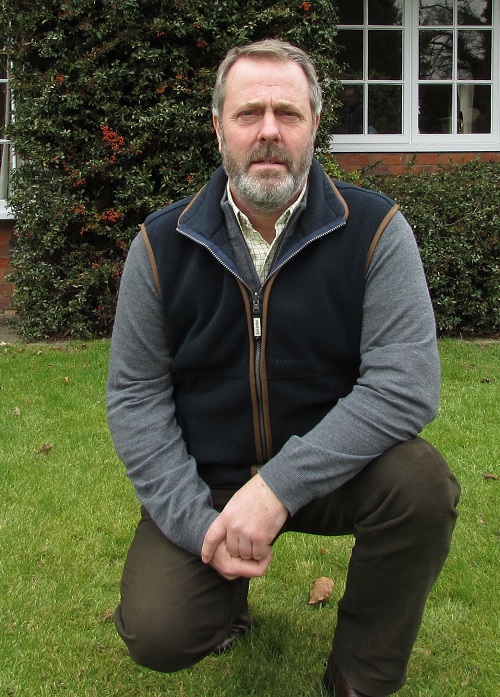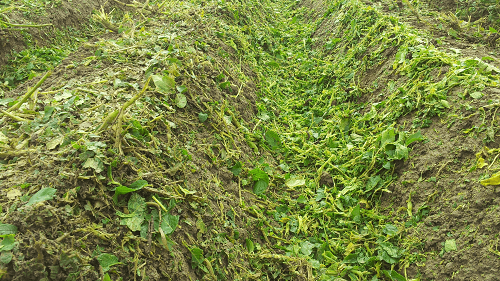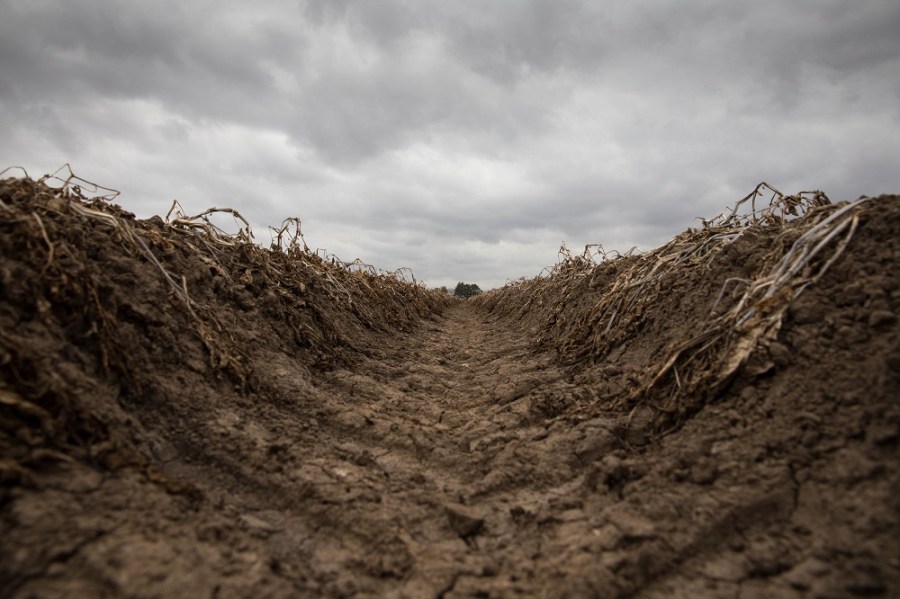Many growers are diquat-dependent at burn down. CPM gathers opinion from those looking at the alternatives.
Based on diquat’s track record of five decades of safe use, concerns are unfounded.
By Lucy de la Pasture
A question-mark hangs over the future of diquat, though the truth is no one really knows what the regulators will decide, believes Frontier potato specialist, Stuart Maltby. But according to Hans Buth, Reglone asset manager at Syngenta, it will be very much business as usual this autumn as far as diquat is concerned.

Stuart Maltby says desiccation is a more complex decision-making process when diquat is removed from the equation.
Outlining the current position with diquat, he says that Syngenta remains hopeful that a positive decision to approve the renewal of diquat (Reglone) in EU28 can be reached.
“Syngenta and relevant stakeholders continue to advocate that a correct technical assessment can lead to a positive decision. Diquat is particularly important to potato growers who depend on it for good quality production at affordable cost,” he says.
The expiry date of the EU registration of diquat has been extended by a year recently by the EU Commission and will now end in June 2018. This will allow the Commission to complete the review process, he explains.
“The European Commission proposed to withdraw the approval of the registration of diquat in March 2016, which is based on concerns related to re-entry of workers, bystanders and residents; and to birds.
“It’s Syngenta’s opinion, based on diquat’s track record of five decades of safe use, these concerns are unfounded and are based on an extremely conservative, precautionary risk assessment, which is inconsistent with other evaluations. This opinion is supported by a number of EU Member States,” he confirms.
Hans Buth believes that without diquat, the sustainable production of potatoes would be seriously undermined.
“Given its unique role as a fast-acting desiccant, diquat helps protect the quality of the potato by preventing the spread of diseases such as blight and viruses to the tuber and improving skin set, helping to ensure production of high quality potatoes,” he adds.
But in the light of the uncertainty, it makes sense to Stuart Maltby to investigate alternative systems of desiccation should the unthinkable happen.

When removing green leaf with the flail, debris will be spread over an area, so it’s really important to be on top of any disease problems.
“When sulphuric acid went, we thought it would be the end of the world but it wasn’t, we developed alternatives. We had worries that diquat would cause internal browning but have learnt that this was being caused by the shock to the plant rather than the diquat itself,” he says.
The big problem for potato growers is that there’s no like-for-like replacement for diquat and the alternatives will prove to be more expensive.
“As a T1, diquat is very good at removing green leaf, leaving stems exposed for a follow up treatment. The alternative desiccants, Gozai (pyraflufen-ethyl) and Spotlight Plus (carfentrazone-ethyl), are best targeted at stems, so naturally slot into the T2 position,” explains Stuart Maltby.
That leaves mechanical methods, such as flailing, as a T1 for green leaf removal. It’s an effective strategy but creates its own set of problems as well as having some advantages, he explains.
“When removing green leaf with the flail, debris will be spread over an area, so it’s really important to be on top of any disease problems, such as blight or blackleg, before considering this change of tack.
That means applying a blight spray immediately in front of the flail may be advisable, he suggests. “Flailing wounds the crop, so it’s more vulnerable to infection. It also opens up the crop, exposing any cracks in the soil so tubers are potentially vulnerable to blight spores on the debris. A mixture of cymoxanil and fluazinam would provide kickback and protection against tuber blight in this situation,” reckons Stuart Maltby.
For those who have already moved to flailing, the increased number of wheelings can be a problem in a wet season, though six-row machines are available which reduce the problem. On the plus side, in a dry season, toppers can be fitted with ridge-rollers to assist with closing up cracks in the soil and reducing the number of greens, he points out.
Stopping regrowth of the potato canopy using desiccation at the first attempt – using chemicals with or without flail and spray – is the key to maximising marketable yield. That means cutting corners by reducing application rates or the number of applications will almost certainly prove to be a false economy, adds independent agronomist and AICC chairman Sean Sparling.
He says that flail and spray has become an increasingly popular method of desiccation, particularly because of the potential restrictions if diquat is withdrawn.
“With diquat under so much regulatory pressure, an alternative option is needed, and flail and spray works just as well at opening up the crop.
“The key to achieving good control is being efficient at the first attempt. I moved away from using diquat as my main desiccant about four years ago, and it has been replaced with Spotlight. We generally don’t need to go in again with a second application as the initial crop kill is usually effective enough, but if the season dictates, we use the lower fixed follow-up rate of 0.6 l/ha.
If a reduced dose rate has been used the first time around it’s far more likely that secondary growth will occur, he says.
Stuart Maltby comments that the number of applications after flailing are likely to depend on the time of year and the how green the variety is when you’re trying to stop the crop in its tracks.
“Processing crops are often in full growth when you need to burn them off and two applications may well be necessary to stop any regrowth,” he says.
In terms of performance, Stuart Maltby believes Gozai and Spotlight are on a par, with very little to choose between them. In the field, you’d be hard pressed to tell the difference between them, he adds.
“Choice of T2 is a personal preference and can come down to the blight sprays the manufacturers will back in a tank-mix. It’s important to maintain as much curative blight cover as possible, while being mindful of harvest intervals,” he says.
Sean Sparling says this year has been an unusual one – a long drought post-planting, followed by heavy rain means that crops are now growing away strongly. Monitoring the size of tubers is essential and when the time comes to stop it growing, it needs to be stopped as quickly and reliably as possible.
“My advice is the same for any year. Once the tuber has reached its optimum marketable size, the haulm should be flailed or otherwise opened up immediately, but a quality operation must be achieved.
Both agronomists highlight the need to allow any debris to wilt after flailing before going in with a follow-up treatment.
“It’s essential to ensure that if you flail, the flailed stems and canopy must not lie across any part of the plant that is still attached, so it makes sense to leave the freshly flailed crop for about 48 hours before going in with a desiccant such as Spotlight to kill off the remaining stems,” says Sean Sparling.
Both Gozai and Spotlight are contact materials, which means that any stems covered over with debris from the flail will not be exposed to the chemical, easily leading to irregular coverage and increasing the need for a follow up treatment, adds Stuart Maltby.
“It’s a more complex decision-making process when diquat isn’t in the equation, with lots of different factors to weigh up. Flailing is fairly harsh and stops growth quickly which can introduce the ‘shock’ factor under some conditions, especially if crops are still in full growth at the time of flailing,” he explains.
Moving away from diquat dependency
For members of Montrose-based cooperative, Grampian Growers, control of tuber size for the correct market is a critical factor in the production of their premium quality seed and baby potatoes.
In the past, the cooperative focused its attention on growing stalwart varieties, such as Maris Piper, Maris Peer and King Edward. But with recent advances in breeding, together with a bespoke programme facilitated by the James Hutton Institute in Dundee, they’re now growing an exclusive variety, Gemson. The new variety is providing a greater proportion of the crop at the desirable size of <45mm, affording the co-op’s growers greater returns.
General manager, Sandy McGowan, is keen to point out that, although the group specialises in seed production, Gemson is very much a dual-purpose variety.
“It’s fast becoming a premium baby potato variety in the UK. Grampian Growers have planted 185ha of certified seed this year and because of its flexibility, we plan for around 35% of the crop at <45mm to be sold for packing and the remaining 65% retained for seed. That’s budgeting on a gross yield of 45-50t/ha.”
Out of 6000t of Gemson grown by the group last year, less than 100t ended up in the less desirable upper >55mm range.
It’s purely a numbers game, says Sandy McGowan. “Gemson has the ability to produce 20-35 tubers/plant, compared to Peer at 12-15 tubers/plant for the same gross yield. That means a higher proportion of the valuable <45mm fraction, where we accurately control the size management. Peer is more of a 50/50 ratio, whereas Gemson can reliably perform at 65/35.”
The genetic advantages that Gemson bring to that market are one thing, but for the variety to deliver commercially, crop management is crucial and especially so at burn off.
Growers are encouraged to accurately flail the tops when the tuber size ratio is optimum and then desiccate rapidly after 48 hours using Spotlight Plus, to ensure that growth is halted and quality preserved by reducing the chance of infection by tuber blight.
“We encourage our growers to be as precise as possible when flailing. Generally, remaining stems should be about 20-30cm in length before we apply the T2. If conditions don’t allow for that, then we might use diquat, followed by the Spotlight Plus, but we’ve noticed a significant increase in size where that’s the case. The more accurate the flailing, then the less work there is for the carfentrazone-ethyl to do.”
For Aberdeenshire potato grower Rodney Harrison, of Clarence Murray (Potato Growers and Farmers), variable weather conditions over his seed and ware crop can often prove testing, across an equally variable mix of soil types.
With 122ha destined for seed and a further 49ha for the ware market, precision crop management is an essential and integral part of his remit, especially when it comes to crop desiccation and post-growth and harvest care.
He’s also an advocate of paying attention to detail when it comes to flailing and believes that if the flailing is carried out precisely enough, it’s a lot easier for the desiccant to work.
“Following flailing, we’ll apply a reduced rate of diquat to assist with any further green leaf desiccation and then within a week, follow up with a second reduced dose of diquat and a full-rate of Spotlight Plus. In some situations, and with certain varieties, a second application of carfentrazone may sometimes be necessary at the lower rate of 0.6l/ha, just to finish the job off.”




